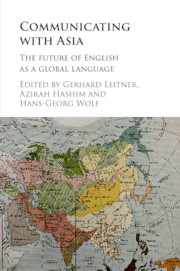Book contents
- Communicating with Asia
- Communicating with Asia
- Copyright page
- Contents
- Figures
- Tables
- Contributors
- Book part
- Communicating with Asia: introduction
- Part I English in selected regional and national habitats with a glance at the role of outward-bound communication needs
- Part II Major other languages in Asia, their international status and impact on education
- Part III Wider perspectives
- Bibliography
- Index
Part II - Major other languages in Asia, their international status and impact on education
Published online by Cambridge University Press: 05 January 2016
- Communicating with Asia
- Communicating with Asia
- Copyright page
- Contents
- Figures
- Tables
- Contributors
- Book part
- Communicating with Asia: introduction
- Part I English in selected regional and national habitats with a glance at the role of outward-bound communication needs
- Part II Major other languages in Asia, their international status and impact on education
- Part III Wider perspectives
- Bibliography
- Index
Summary
How does one communicate in a multilingual society with staggering linguistic diversity? To best characterize the multifaceted dimensions of multilingual communication in India, this chapter will focus on the contemporary and historical study of Hindi–Urdu and Indian English, and their spread in intranational diasporic contexts (e.g., from North to South India) and international diasporic contexts (particularly in South-East Asia). The chapter argues that multilingualism in India is shaped primarily by natural forces of networking and communication (e.g., media, literature, trade, multiple identities, etc.) rather than being the result of exclusive and externally imposed models based on government planning. Shaped by such natural forces, linguistic accommodation with multiple dimensions plays a key role in the formation of the linguistic and transactional characteristics of Hindi–Urdu in intranational and international contexts (as well as English).
- Type
- Chapter
- Information
- Communicating with AsiaThe Future of English as a Global Language, pp. 153 - 246Publisher: Cambridge University PressPrint publication year: 2016



